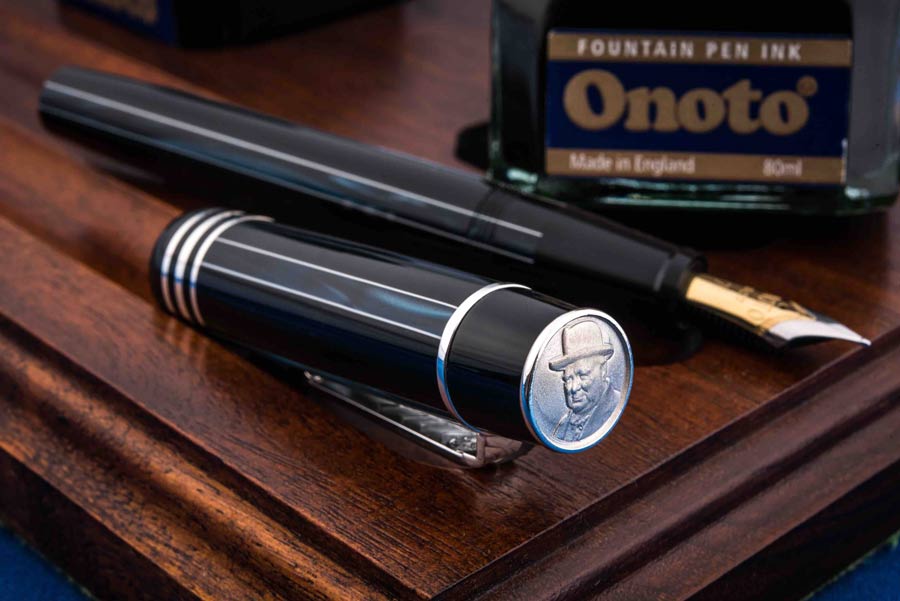Proudly Onoto, proudly British!
James Boddy is an entrepreneur, born in the 1940s. He joined the merchant navy when he was a young man and attended the same school as Admiral Lord Horatio Neslon, who has always been his hero. James’s connection with Onoto started in 1999 when he acquired 33 tons of oak and 10 tons of copper recovered from HMS Victory (the ship that was historically associated to Nelson) in preparation to ‘Remember Nelson’ on the occasion of the 2005 Bicentenary of the Admiral’s death at the Battle of Trafalgar. A contact led him acquire The Onoto Pen Company so that he could make the Nelson pen under the prestigious British brand of Onoto. The Nelson and Emma pen have been a great success. He melted the copper into the silver to make the trademarked “Victory Silver” so that every pen connects to the ship that Nelson fought on.
Q. What does Onoto really mean? The oft repeated explanation that the name sounds the same in all languages, has also been questioned with reference to Ono Tokusaburo, who apparently had a patent, some features from which may have been incorporated in the Thomas De La Rue stylos at the turn of the 20th century? What about the “Onoto” red pigment that was used in making pens, that some seek to link the name to?
With all the original company records destroyed during the London blitz during the WWII, we can only assume that the name came from the first five letters of the inventor Ono Tokusaburo.
Q. Queen Mary, Florence Nightingale, Winston Churchill … the list of epoch makers who wielded an Onoto Fountain Pen is endless. What made Onoto writing instruments their preferred weapon?
From launch, Onoto is known for quality and innovation, proud to be British in a time of global uncertainty.
Q. The Thomas De La Rue, Onoto and India’s connections go a long way back, yet somehow the bonds have never been put under the arch lights the way they deserved. What is your take on this? Are there any India specific plans for Onoto pens? Surely, there will be many in India who would cherish the essentially pukka Britishness of Onoto pens, to the extent of even considering your impeccable manufacturing ingenuity secondary?
We are always open to receive design ideas for the creation of a pen to honour the Onoto / India specific fountain pen.
Q. Sir Thomas Carmichael’s Onoto Medina which has been retrieved from the sea bed and writes perfectly after spending seven decades under water is another example of the manufacturing prowess that is synonymous with Onoto pens. Can you please recount the fascinating tale – of the retrieval, the restoration and the revival of the historic piece?
Sent to the ocean bed by a WW 1 U-boat in 1917 – this Onoto fountain pen still writes perfectly after 70 years underwater!
Onoto British-made pens have a long-standing reputation for quality, but a recently discovered example of one of their earliest pens takes the prize for outstanding durability: it writes perfectly after spending 70 years at the bottom of the English Channel!
Guaranteed not to Leak!
The pen is thought to have been manufactured in London around 1906 by Thomas De La Rue & Co, the postage stamp and bank note printers, for their fledgling pen company, Onoto. It is one of the earliest plunger-filling fountain pens, using an innovative mechanism which was the successor to the very messy eye-dropper method of putting ink in pens. At last there was a mechanical, automatic way to fill pens without getting your fingers covered in ink! What’s more, the filling mechanics meant that the pen could be ‘locked’when in transit so it wouldn’t leak (another messy failing of earlier pens). In fact this Onoto model was widely advertised as the first pen “Guaranteed not to leak”.
Sent to Australia and India – by Royal Command
The pen belonged to Sir Thomas Carmichael, a British diplomat who had spent the early part of his career as Governor of Victoria, Australia and then in 1911 was posted to India to become Governor of Madras and Bengal. King George V, who had sailed to India on the SS Medina, P & O’s most modern steamship, was behind Sir Thomas’s appointment. The Medina, built at Greenock in 1911 for the mail run to Australia, had been fitted out in red, white and blue as a Royal Yacht – and plays an important role in the history of our much-travelled pen. Around this time, Mahatma Gandhi was beginning to create a name for himself through his ‘passive resistance’ tactics against the British;tactics which ultimately led to the end of the British Raj and independence for India in 1947.
Leaving Bombay sunk by a German U-Boat
The cargo manifest shows that in addition to the Carmichaels’ belongings, Medina is carrying Australian meat and butter for the war-starved British, plus tons of copper, tin and gold ingots. By good fortune or great planning, Medina offloads the gold at Plymouth before continuing the last leg of her journey to London.
But soon after she leaves Plymouth, German U-Boat UB31 spots her 4 miles off Start Point in South Devon. In the perfectly calm conditions, Medina is an easy target. A single torpedo is all it takes to send her to the bottom,taking Sir Thomas’s 80 cases with her, including his much loved Onoto which had accompanied him throughout his service in Australia and India.
Salvaged after 70 years
And there it stayed for 70 years until a salvage company, exploring the wreck in 1987, recovered many of Sir Thomas’s artefacts – including his Onoto fountain pen. The mud had left many objects in an extraordinarily good state of preservation. There was, as expected, a large Oriental art collection; Indian brass ware and an elaborate wooden chair; Japanese porcelain; netsuke; Chinese carving; letters from Kitchener and Lord Rosebery which were still legible;watercolours; jars of scent; perfectly sharpened pencils; an Assyrian cuneiform seal and bright Ancient Egyptian beads, striped in gold; Sir Thomas’s Masonic jewels and his KCMG order. There was also a good deal of jewellery: amethyst and diamond cuff links, and fiery Australian opals, which were just beginning to be mined in the first decade of the century, when Sir Thomas was Governor of Victoria.
Since 1987 the majority of the pieces recovered have been sold at auction, but it was only recently that Sir Thomas’s Onoto pen was advertised on an online auction site. The current directors of Onoto, intrigued by the story and keen to acquire the pen for their corporate collection, won the bid and were delighted to see it in such good condition. The vulcanite cap and barrel in particular showed no ill effects from 70 years underwater – only the scuffs and scratches that came from years of use in Australia and India before it sank beneath the waves.
Original Components Fully restored and in excellent condition
The Onoto directors sent the Medina Onoto to renowned ‘pen doctor’ Laurence Oldfield for an assessment of its condition and within days he reported that it was in excellent shape for a pen which had been under water for more than 70 years! It needed new seals and piston as both had corroded –but any pen of that age would need to have these parts replaced. The good Dr Oldfield even sourced a new piston rod from a willing donor pen of approximately the same vintage as Sir Thomas’s pen.
Ready for assembly
The acid test though was the condition of the nib. Made of 14 carat gold, it had been preserved remarkably well and looked as good as new. When tested for the first time in over 90 years, the ink flowed smoothly and evenly on to the page.
First use for more than 90 years
Now fully restored, the 100+ year old Medina Onoto is regularly used by one of the Onoto Pen Company directors. What finer way to recognise and cherish the quality, resilience and longevity of Onoto pens?
If only it could speak, what an incredible tale this extraordinary pen would have to tell!
For More information on the story refer to the article on the Onoto website (https://onoto.com/story/sent-to-the-ocean/).
Q. What are the major new initiatives, like the Spitfire P7350, being undertaken by Onoto pens?
We are always introducing new colours to our pens. Next year, we plan to launch some exciting new silver overlays and new pinstripe pens.
Q. It is more than a hundred years since you began the journey of creating writing instruments of exemplary quality and have seen it all – the great wars, socio-economic upheavals, ball point aggression, digital domination (or is it damnation?) – how does the fountain pen industry look to you, from your vantage point? What does the future hold for the fountain pen in general and legacy pen brands like Onoto in particular?
We embrace the present and future with optimism, always seeking to produce quality writing instruments that will delight our custodians.
Q. Is the art of writing – not just calligraphy, but writing in general – slowly dying out? How can we stave off, what many are already considering to be the obvious?
There is always a market for quality fountain pens, and we aspire to encourage the continued use of fountain pens.
Q. What will be your message to our children, many of whom are still to hold a fountain pen in their hands? Why should they pick up the pen?
My pen connects directly to my soul, the essence of my being.Allowing me to fully express my feelings and emotions on paper. No digital system comes to close.
Q. Anything that you would like to communicate to our readers
The Chairman loves following Indian Cricket team. You currently have the world’s best batsman Virat Kohli. Onoto looks forward to heritage, re connection , with rich history of Onoto in India, we should work together to rekindle the relationship.
For More Information:

